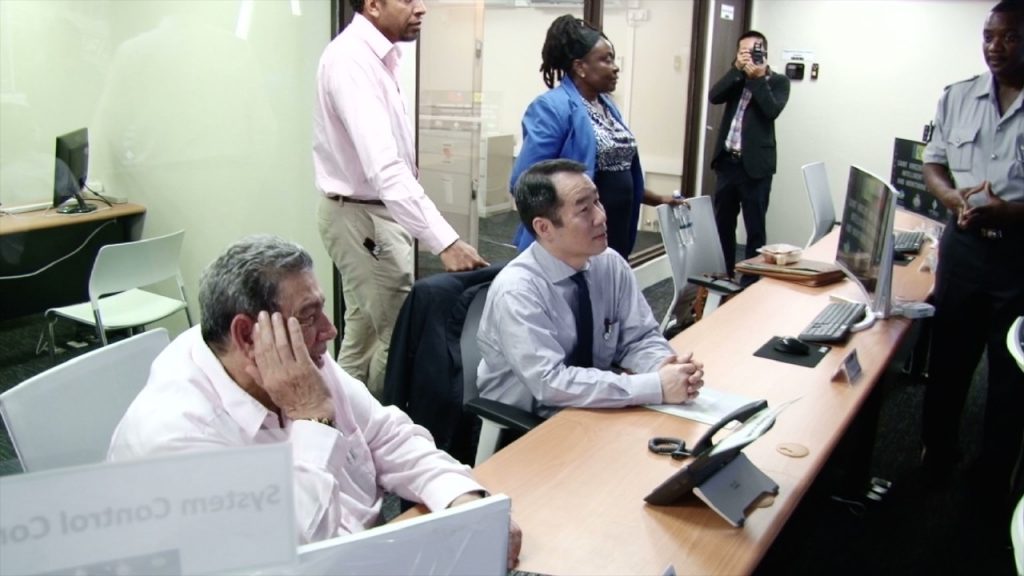The surveillance monitoring system, installed at various points in this country, is already aiding the Royal St. Vincent and the Grenadines Police Force (RSVGPF) in their investigations.
Speaking at the unveiling of the Intelligent Bus Management and Monitoring System at the Questelles Police Station on Tuesday July 21st, 2020, head of Telecommunications in the RSVGPF, Sergeant Olson Rodney, disclosed that they have already received requests from within the Force for evidence gathered from the CCTV cameras. To Prime Minister Gonsalves, Rodney stated, “thanks very much for this vision and the thought behind of it. I wanna thank Taiwan for what they have done for us. This is a very important tool for us, for fighting crime.”
The Intelligent Bus Management and Monitoring System Project, funded by the Taiwan International Cooperation and Development Fund (ICDF), was implemented in partnership with the Royal St. Vincent and the Grenadines Police Force (RSVGPF), the Information, Technology Services Division (ITSD), and the Ministry of Transport, Works, Urban Development and Local Government.
The Project also include the installation of CCTV cameras in and around the country, and education and training of about 100 persons. Director of the ITSD, Mrs. Jacintha Fergus, thanked everyone who worked on the Project to make it possible. Fergus expressed special thanks to Minster with responsibility for Information Technology Hon. Camillo Gonsalves for his enthusiasm about the Project.
The Monitoring System Project will assist this country to enhance surveillance in public areas. Addressing Tuesday’s event, Commissioner of Police Colin John said it was a very happy and proud day for him. He said “I have an important piece of tool in the Police arsenal so that we can fight crime. We also have trained persons who can handle this piece of tool and can assist in making St. Vincent and the Grenadines a safer place.”
Hon. Camillo Gonsalves, Minister of Finance, said the Intelligent Bus Management and Monitoring System Project is one that people can see. “Right now, there are people in St. Vincent and the Grenadines, according to data, waiting between 25 and 70 minutes for their bus — standing up waiting. This service, when implemented, will place a small transmitting device in 200 buses, to begin,” Minister Gonsalves disclosed. He further said that they have consulted with bus drivers and “some of them are looking forward to adopting this project.” Accordingly, persons with the use of an app will be able to check their cell phones to see when a bus is on the way, the Minister of Information Technology stated.
In January of 2019, the Governments of St. Vincent and the Grenadines and the R.O.C. Taiwan, respectively, signed an agreement to implement the Intelligent Bus Management and Monitoring System Project. At the completion of the first phase of the Project, Ambassador of the R.O.C. Taiwan to St. Vincent and the Grenadines, H.E. Calvin Ho, shared how happy he was to witness its opening. H.E. Ho said the Project is a “very important milestone in the development of smart cities in St. Vincent and the Grenadines.”
Prime Minister and Minister with responsibility for National Security the Hon. Dr. Ralph Gonsalves also expressed his happiness to witness the Project opening. The Project, according to him, has a next phase. “As I understand it they are going to build intelligent bus stops — 40 bus stops across St. Vincent and the Grenadines — and then when we are finished, we are going to ask for the Volunteers to install on board buses, a particular unit to assist with the tracking [of] 200 buses, and in time, we can do more,” Prime Minister Gonsalves disclosed.
At the end of the official ceremony, Project Manager of the Taiwan ICDF, David Fu, gave Prime Minister Gonsalves and Ambassador Ho, among others a tour of the Project.


1 Comment
An intelligent bus sytem operated on behalf of uninteligent bus drivers. What they should be doing is puting technowledgy in every bus that records the speeds on a graph, each month replaced by a police department and then anylised for excess speed. It has been used in many other countries in the world for the last 30 years for public transport vehicles.